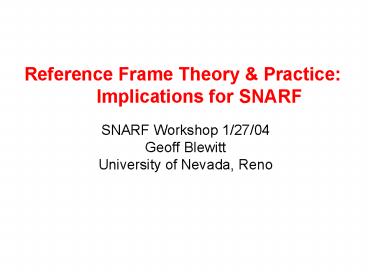Reference Frame Theory
1 / 15
Title: Reference Frame Theory
1
Reference Frame Theory Practice Implications
for SNARF
- SNARF Workshop 1/27/04
- Geoff Blewitt
- University of Nevada, Reno
2
Overview
- Reference system versus reference frame
- Frame realization
- Choice of system
- Use of frames in practice
- Scientific interpretation issues
- Issues for use to consider
3
Frame versus System
- Reference System
- Set of conventions
- Reference Frame
- Set of coordinates of physical points (stations,
quasars) consistent with conventions
4
Frame versus System
- Reference System
- Axiomatic ideals
- no-net translation wrt, no-net rotation
wrt. - Frame parameters Origin, orientation, scale,
- Evolution of above with time
- Typically includes physical concepts(center of
mass of whole Earth system,) - Therefore creating the ability to tie various
observation sets into one integrated system
(grand unified geodesy) - Conventions
- speed of light, SI units,
- Conventional models
- example station motion models (usually well
known, or at least functional form is known, such
as rigid plates)
5
Grand Unified Geodesy
Geocentric Sea Level
Mass Exchange
Land Load
Satellite Altimetry
Relative Sea Level
-
Deformed Ocean Bottom
Equipotential Sea Surface
Remote Sensing
Surface Load
Moment of Inertia
Angular Velocity
Gravitation
Momentum
Earth Rotation
Geocenter Motion
Load Potential
Satellite Laser Ranging
VLBI
Centrifugal Potential
LLN Theory
Frame Theory
Solid Earth Deformation
Gravity Potential
Gravitational Potential
Satellite Gravimetry
Global Positioning System (GPS)
6
Frame versus System
- Reference Frame
- A specific realization of a reference system
- consistent with its conventions
- based on physical observations
- In our case
- Selected set of GPS stations
- Specified parameters of the station motion model
- position coordinates at some conventional epoch
- velocity coordinates
- Instantaneous coordinate offsets (e.g.,
co-seismic,) - or more generally set of coordinates at many
epochs - Note that the frame depends on
- Definition of the reference system, particularly
the models - Adopted set of stations
- Adopted set of observations leading to parameter
estimates
7
International GPS Service Network
8
Frame RealizationIGS Polyhedron Assembly
9
Frame Realization
- Steps
- Adopt reference system as part of GPS observation
model - Solve for unknown parameters for station motion
model (coordinates at reference epoch, velocity
components, discontinuities...) - This is a fiducial-free (loose) kinematic
solution - strictly not in a reference frame
- but the network is tied to the center of mass of
the Earth system - Select a subset of stations in the solution which
are defined by a specific frame (e.g., ITRF00) - Solve for and apply a generalized Helmert
transformation to minimize residuals to defined
frame - translation, orientation (and scale is optional)
- translation rate, orientation rate (and scale
rate is optional) - Note that final solution depends on
- Selection of stations, and coordinate errors in
ITRF00 - Conventional models (and errors!) in the IERS
Reference System
10
Choice of System
- Conventional considerations
- Should for the most part be consistent with IERS
Reference System - Interpretive considerations
- Interpretation may be facilitated if frame is
such that the North American plate appears
stationary - Question
- Is it sufficient to specify stable North
America by selecting a subset of the network
that does not appear to deform? - Or can models can be implemented that make some
specified portion of North America appear more
like a rigid plate?
11
Using a Frame in Practice
- Fiducial method
- Hold subset of stations fixed to frame
coordinates - Fiducial-free method
- Solve for all station coordinates, then solve and
apply (generalized) Helmert transformation - Transformation method
- Solve for stations in one frame, say ITRF00
- Apply a known transformation into the desired
frame(e.g., remove rotation of North America in
ITRF00) - In all cases, models may also need to be applied
to be consistent with the plate-fixed reference
system
12
Frames and Interpretation
- From Jim Davis Vertical velocities (mm/yr) in
North America - Is this real or is it a frame problem?
13
Interpretation Issues
- Choice of frame
- Should be to facilitate interpretation
- Should not introduce unnecessary errors
- Errors
- In frame itself (specific station coordinates)
- In reference system models
- Coordinate system problems
- Horizontal and vertical trade off if the
frame has a translation rate bias (imagine a
translating sphere) - Even strain inferred from velocities are not
immune! - A translation rate bias in the frame causes
relative horizontal coordinates (latitude,
longitude) between stations to vary. - And can create anomalous vertical motions
14
A Perfect Example Degree-1 Deformation
Motions appear to be horizontal
Motions appear to be vertical
PARADOX The deformation is actually identical !
15
Issues for Us to Consider
- Which reference system will best suit our needs?
- What would be ideal?
- What is actually possible?
- Can ITRS conventions be adopted or improved?
- Which stations to select in the frame?
- What is the station motion model?
- Part specified by the reference system itself
- Part estimated by GPS data
- How should our product (systemframe) be
produced and tested? - How do we ensure it gets used and is useful ?































